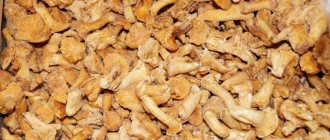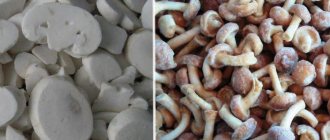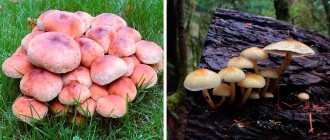Red-haired chanterelle beauties are not among the top three mushrooms, where white mushrooms, saffron milk caps and milk mushrooms took the prizes. But their appearance on the table is always greeted with enthusiasm.
Fried chanterelles are one of the most delicious mushroom dishes. But this cooking method requires preliminary preparation: chanterelles are characterized by not very pleasant bitterness and sourness. They need to be eliminated.
Causes of bitterness
There are two reasons why the taste of chanterelles is bitter: errors during harvesting and improper preparation of mushrooms for storage.
Improper harvesting
Chanterelle mushrooms become bitter if they are collected at the wrong time - on dry soil. Also, taste qualities depend on the place of growth. You should not pick mushrooms near highways or large industrial enterprises: they absorb toxic substances. Bitterness is also characteristic of chanterelles that are located near coniferous plants or surrounded by moss.
Inexperienced mushroom pickers may accidentally put false chanterelles in the basket, which have an unpleasant bitter taste. They are distinguished by the bright orange color of their caps (the real ones are deep yellow). The bitter taste quickly spreads to other mushrooms, so you should learn to distinguish edible from poisonous.
Incorrect workpiece
Chanterelles also taste bitter after freezing if they are not processed according to the rules. To prevent this from happening, perform the following actions:
- cleaned of debris, cut out rotten areas, discarded low-quality ones;
- washed several times;
- pour cold salted water;
- after 1.5-2 hours, drain and dry.
Manipulations are carried out immediately after collection. If the product sits for a certain time, it will accumulate a lot of toxic substances.
Mushrooms need to be boiled before freezing.
Some housewives prepare mushrooms raw, but then frozen chanterelles taste bitter. To get rid of the unpleasant taste, they are pre-boiled (first 10 minutes, then change the water until cooked). The cooled fruits are placed in sealed containers. They are placed in the freezer in small portions (the product cannot be re-frozen). Frozen cooked mushrooms are more compact than raw ones. This helps save space.
For first courses, mushrooms are frozen along with the broth in which they were boiled. This is a convenient method for future preparation because it does not require defrosting. The briquettes removed from the freezer are immediately thrown into the pan.
Larger chanterelles become bitter after freezing, so you should choose small specimens (the caps should not open). They contain more useful substances.
Rules for freezing fresh mushrooms
It is recommended to freeze fresh only young chanterelles whose caps have not completely straightened.
The harvest is carefully sorted and sorted, selecting only small specimens. After this, carefully clean the mushroom caps from debris and cut off the stem at the bottom.
Then the crop is washed with water, thoroughly washing out the sand and small debris under the caps. After washing, the mushrooms are laid out on a towel until completely dry.
To get a scattering of separately frozen chanterelles, they are frozen in parts. First, 1 layer is laid out in a tray, after which it is frozen.
After a few hours, the mushrooms are transferred to containers or plastic bags, and the next batch is prepared for freezing.
How to remove bitterness from thawed mushrooms
When Chanterelles taste bitter after freezing, you should try to remove the unpleasant taste. To do this, the mushrooms are defrosted at room temperature or placed in cold water.
If heat treatment was not carried out before freezing, perform the following actions:
- soak overnight in cold salted water;
- Boil (up to 8 minutes), adding salt or a pinch of citric acid, drain and replace the water.
If the bitter chanterelles were pre-cooked, after defrosting they should be marinated or cooked by adding spices: bay leaf, cloves, peppercorns, dill - or vinegar.
If all the recommendations are followed, and the vegetables give the dish a bitter taste, the reason often lies in low-quality sunflower oil. A product that is burnt during cooking can also give off a bitter taste. In this case, you should add sour cream or mayonnaise to it and simmer for 15 minutes.
How to dry whole chanterelles in the oven. Photo recipe No. 2
Drying chanterelles in their entirety in the oven is practically no different from the previous cooking method. Whole chanterelles are thoroughly cleaned of debris and wiped with a napkin or slightly damp cloth. Then they are laid out on the oven rack and heated to a temperature of 70-75 degrees, no more.
The door is left half open so that air circulates freely and moisture from the mushrooms evaporates. Dry chanterelles become easily bendable, but do not break or crumble.
How to remove bitterness from dried chanterelles
If the fruiting bodies had a bitter taste, it will remain not only when frozen. Dried chanterelles will also taste bitter. One of the following methods will help remove the unpleasant taste:
- Pour in cold salted water for 5-8 hours. Change it several times throughout the day, otherwise souring will occur.
- Immerse completely in warm milk. Leave for 2-3 hours.
Then the dried vegetables should be boiled again. Spices and citric acid are added to the broth.
Thanks to their excellent taste, wild chanterelle mushrooms have gained immense popularity in cooking. They are good for any processing: frying, boiling, salting, freezing, drying and pickling. But they can taste bitter and this happens for various reasons. Practical advice from experienced housewives will help you cope with this problem.
Causes of bitterness in chanterelles
Composition and properties of chanterelles
Chanterelle contains polysaccharides necessary for normal metabolism:
- chitinmannose has anthelmintic properties, so you won’t find worm-eaten chanterelles, the mushrooms are kept fresh for a long time and are easily transported;
- ergosterol is provitamin D2, protects liver cells from destruction and prevents the development of hepatitis;
- trametonolinic acid has a negative effect on viruses and has antitumor activity.
Chanterelles grown in the forest are a rich source of amino acids, vitamins D, A, B, PP, zinc, and copper.
Chanterelle in its raw form has soft, dense flesh and a slightly sour taste, which completely disappears when cooked.
Collection and processing
There are 2 reasons for the appearance of bitterness in mushrooms:
- Failure to comply with collection rules. Chanterelles become bitter after being collected in dry weather if they are collected near roads or industrial zones. In addition, chanterelles, which grow surrounded by moss and coniferous trees, are susceptible to this.
- Failure to comply with the rules of preparation for further storage. To eliminate bitterness you need:
- clean the chanterelles from debris, cut out rotten and injured areas;
- rinse them under running water several times;
- pour saline solution for 1 hour (1 tsp per 1 liter of water);
- then drain the water and dry the product.
Fickle chanterelles
Even experienced mushroom pickers, who perfectly understand what exactly they put in the basket and how to prepare it, from time to time end up with a completely inedible dish. What's the matter? After all, there are chanterelle mushrooms in the frying pan.
Why do they taste bitter, although they were tasty when collected a week earlier in the same place? The answer is simple: climate. If there is not enough water, the juice inside the fruiting bodies becomes bile. That’s why mushrooms collected in the summer heat taste bitter.
The same applies to chanterelles found in moss in a spruce forest - the acrid taste of resin makes them virtually inedible.
After freezing
Usually chanterelles become bitter after freezing due to picking in dry weather. To get rid of bitterness, you need to soak them before putting them in the freezer. Many housewives boil mushrooms for further freezing in order to completely get rid of the unpleasant aftertaste and to be sure that if the chamber suddenly defrosts, the mushrooms will not be lost.
Chanterelles can be frozen with broth in an airtight container, and after defrosting, immediately transfer to a pan for cooking.
There are two ways to remove bitterness from frozen mushrooms after defrosting:
- place in boiling water and cook for 15-20 minutes over low heat;
- fill with saline solution (1 tbsp/l of water) and add 3 pinches of citric acid.
After defrosting, the mushrooms are soaked for half an hour, then washed, transferred to a saucepan and filled with clean water. They should be cooked over low heat with the addition of one onion, cut into quarters, for 10 minutes.
Large mushrooms have a very noticeable bitterness, so use small and medium-sized specimens for storage in this form. After defrosting, they are practically not bitter.
You can freeze not only boiled, but also raw chanterelles, very young ones whose caps have not yet opened. This will guarantee you no bitterness in the future.
Causes of bitterness in chanterelles
Thanks to their excellent taste, wild chanterelle mushrooms have gained immense popularity in cooking. They are good for any processing: frying, boiling, salting, freezing, drying and pickling. But they can taste bitter and this happens for various reasons. Practical advice from experienced housewives will help you cope with this problem.
Causes of bitterness in chanterelles
Collection and processing
There are 2 reasons for the appearance of bitterness in mushrooms:
- Failure to comply with collection rules. Chanterelles become bitter after being collected in dry weather if they are collected near roads or industrial zones. In addition, chanterelles, which grow surrounded by moss and coniferous trees, are susceptible to this.
- Failure to comply with the rules of preparation for further storage. To eliminate bitterness you need:
- clean the chanterelles from debris, cut out rotten and injured areas;
- rinse them under running water several times;
- pour saline solution for 1 hour (1 tsp per 1 liter of water);
- then drain the water and dry the product.
All these procedures are carried out immediately after collecting mushrooms, otherwise they will become saturated with toxic substances and will taste bitter.
Due to inexperience, many mushroom pickers confuse real chanterelles with false ones, which contain a bitter aftertaste. Real mushrooms have a rich yellow cap, while false mushrooms have an orange cap.
Signs of false chanterelles (orange talkers)
- Habitat: coniferous and mixed forests (deadwood, old fallen trees, forest litter, moss).
- They grow in groups or singly, reaching a maximum in late summer and autumn.
- Cap color: bright orange or orange with a brown tint, lighter along the edge than in the center.
- The surface of the cap: velvety to the touch and to the eye.
- The edges of the cap: even and smooth, neatly rounded.
- Cap diameter: 3-6 cm.
- The shape of the cap: in older specimens it is funnel-shaped, in young specimens it is slightly convex.
- Hymenophore plates: thin, frequent, branching, orange, descend to the stalk, but do not pass onto it.
- Pulp: yellow, with an unpleasant odor, tasteless, loose. When pressed, the color does not change.
- Stipe: thin, hollow in adult specimens, clearly demarcated from the cap.
The bitter taste of false chanterelles quickly transfers to good mushrooms.
After freezing
Usually chanterelles become bitter after freezing due to picking in dry weather. To get rid of bitterness, you need to soak them before putting them in the freezer. Many housewives boil mushrooms for further freezing in order to completely get rid of the unpleasant aftertaste and to be sure that if the chamber suddenly defrosts, the mushrooms will not be lost.
Chanterelles can be frozen with broth in an airtight container, and after defrosting, immediately transfer to a pan for cooking.
There are two ways to remove bitterness from frozen mushrooms after defrosting:
- place in boiling water and cook for 15-20 minutes over low heat;
- fill with saline solution (1 tbsp/l of water) and add 3 pinches of citric acid.
After defrosting, the mushrooms are soaked for half an hour, then washed, transferred to a saucepan and filled with clean water. They should be cooked over low heat with the addition of one onion, cut into quarters, for 10 minutes.
Large mushrooms have a very noticeable bitterness, so use small and medium-sized specimens for storage in this form. After defrosting, they are practically not bitter.
You can freeze not only boiled, but also raw chanterelles, very young ones whose caps have not yet opened. This will guarantee you no bitterness in the future.
Fried
Mushrooms need to be processed immediately after collection.
The bitterness in fried chanterelles may result from mixing false and real mushrooms. If in doubt, they should be disposed of as... In this case, it will no longer be possible to remove bitterness from a fried product.
The second option why chanterelles become bitter when fried is untimely processing, as a result of which the mushrooms accumulate toxic substances and begin to taste bitter. To avoid this, immediately after collection they need to be sorted and filled with cold water for 2 hours. After soaking, rinse under clean water and start cooking.
If all the recommendations are followed, but the chanterelles are still bitter, perhaps this taste comes from the vegetable oil in which they were cooked. To remove the bitterness, they need to be seasoned with any sauce and simmered over medium heat for 15 minutes.
There is another way to eliminate the bitterness of mushrooms before frying - first soak them in water using the technology described above, and then boil them in a marinade with the addition of cinnamon, bay leaf, dill, cloves and parsley. Cooking time – 15 minutes. If after this the mushrooms still have a bitter taste, they should be thrown away, because... The bitterness will not go away after frying.
Dried
Often the cause of bitterness in dried mushrooms can be untimely processing, collection in dry weather or cutting of chanterelles growing near pine needles and surrounded by moss.
The following manipulations will help get rid of the unpleasant taste:
- soaking in salt water for 6-8 hours. Use a solution of 2 liters of water and 2 tbsp. l. salt. During this time, the water must be drained three times and replaced with a new solution;
- pour warm milk (40 °C) over the mushrooms and leave for 3 hours. Then drain the milk and rinse the mushrooms under clean water;
- Before drying, they can be additionally boiled in salted water with the addition of bay leaf, cinnamon, cloves and dill.
Fried
Mushrooms need to be processed immediately after collection.
The bitterness in fried chanterelles may result from mixing false and real mushrooms. If in doubt, they should be disposed of as... In this case, it will no longer be possible to remove bitterness from a fried product.
The second option why chanterelles become bitter when fried is untimely processing, as a result of which the mushrooms accumulate toxic substances and begin to taste bitter. To avoid this, immediately after collection they need to be sorted and filled with cold water for 2 hours. After soaking, rinse under clean water and start cooking.
If all the recommendations are followed, but the chanterelles are still bitter, perhaps this taste comes from the vegetable oil in which they were cooked. To remove the bitterness, they need to be seasoned with any sauce and simmered over medium heat for 15 minutes.
There is another way to eliminate the bitterness of mushrooms before frying - first soak them in water using the technology described above, and then boil them in a marinade with the addition of cinnamon, bay leaf, dill, cloves and parsley. Cooking time – 15 minutes. If after this the mushrooms still have a bitter taste, they should be thrown away, because... The bitterness will not go away after frying.
Collection rules
If you want to get a good mushroom harvest, then during harvesting you must adhere to certain rules. The first thing you need to pay attention to is the place where the chanterelles grow. You shouldn't look for them near the road. It is also not recommended to collect fruiting bodies in industrial areas.
This type of mushroom has the ability to absorb toxic substances and accumulate them. They are especially sensitive to exhaust gases and all kinds of poisons. This affects not only the taste of the product, but also the safety of its use.
Dried
Often the cause of bitterness in dried mushrooms can be untimely processing, collection in dry weather or cutting of chanterelles growing near pine needles and surrounded by moss.
The following manipulations will help get rid of the unpleasant taste:
- soaking in salt water for 6-8 hours. Use a solution of 2 liters of water and 2 tbsp. l. salt. During this time, the water must be drained three times and replaced with a new solution;
- pour warm milk (40 °C) over the mushrooms and leave for 3 hours. Then drain the milk and rinse the mushrooms under clean water;
- Before drying, they can be additionally boiled in salted water with the addition of bay leaf, cinnamon, cloves and dill.
Boiled
There are several reasons why boiled chanterelles taste bitter:
- the presence of toxic substances in the pulp;
- incorrect and untimely processing of collected mushrooms;
- using too large (old) specimens with increased bitterness.
After boiling in salted water, bitter chanterelles can be prepared with the addition of various sauces that will soften the unpleasant taste.
Irina Selyutina (Biologist):
To prevent the chanterelles from becoming bitter after boiling, add salt, citric acid (1-2 pinches), bay leaves, clove buds, and allspice peas to the water. After boiling, cook the mushrooms for 5-8 minutes. Then the water is drained and new water is added. The mushrooms are boiled again, but without spices and salt.
Why do chanterelles taste bitter after freezing and what should you do if the mushrooms are bitter when defrosted?
Why do chanterelles taste bitter after freezing and what can I do to fix it? Indeed, when taking frozen mushrooms out of the freezer in winter, you can sometimes detect a slight bitterness. If you do not immediately pay attention to this, the prepared dish may be spoiled.
So, why do chanterelle mushrooms taste bitter after defrosting, and what rules should you follow to avoid this? To ensure that there is no unpleasant bitter taste after defrosting, the following recommendations are followed before harvesting:
- Mushrooms are cleared of forest debris, soil or sand and immediately cut off rotten areas.
- Wash thoroughly in plenty of water, stirring with hands.
- Pour in cold water and leave for 1.5-2 hours.
- Drain the water, place the mushrooms on a wire rack and leave for 20-30 minutes to drain.
- After this, the chanterelles are distributed into plastic bags or food containers and placed in the freezer.
Why are chanterelles bitter?
The chemical composition per 100 g of product is as follows:
- water - 88.5 g;
- dietary fiber - 7 g;
- carbohydrates - 1 g;
- fats - 1 g;
- proteins - 1.5 g;
- ash - 1 g.
There is no starch, cholesterol or trans fats in the product. The special chemical composition of chanterelles also includes certain polysaccharides and the substance quinomannose, due to which the taste of bitterness is present in the pulp. It is worth noting that because of this, these mushrooms are never wormy.
Did you know? In California, competitions dedicated to these mushrooms are held annually. Chefs from different cities come to the festival to demonstrate original cooking methods.
Pests do not tolerate the above components, as a result of which they do not affect the fruiting bodies. This problem can be easily corrected if you adhere to certain rules for collecting and processing mushrooms. You will learn about this in more detail later in the article.
Why are frozen chanterelles bitter and how to remove bitterness from thawed mushrooms?
But sometimes, even despite following the rules, frozen chanterelles taste bitter, why? It would be better to boil the mushrooms after soaking so that the bitterness goes away for sure.
Another factor why frozen chanterelles remain bitter is the time of harvest. During the dry mushroom season, mushrooms always contain bitterness, which is difficult to remove by soaking.
How can you remove the bitterness from frozen chanterelles if they were prepared raw?
- After defrosting, the mushrooms are immersed in boiling water and cooked for 10-15 minutes over low heat.
- You can add 1 tbsp to the water. l. salt and 2-3 pinches of citric acid. Such actions will help remove the bitter taste from the fruiting bodies.
In addition, heat treatment will give you confidence that the product will not deteriorate after accidentally defrosting the freezer. It is worth adding that boiled chanterelles become more compact and take up less space in the freezer than raw ones.
How to cook chanterelles so they don't taste bitter
Chanterelles are tasty and healthy. The orange color indicates that they contain a large amount of easily digestible carotenoids. Conventional cooking methods, including freezing, will not allow the extraction of substances beneficial to the body; they are destroyed at a temperature of +50°C. Therefore, boiling, frying, or any other culinary processing almost completely destroys the active healing principle.
Advice! For medicinal purposes, mushrooms are eaten raw.
Medicinal oil tincture
For the recipe you will need the following products:
- rapeseed oil;
- garlic – 10-15 teeth;
- chanterelles – 300 g;
Preparation:
- Raw chanterelles are washed and finely chopped with a knife.
- Transfer to a clean 0.5 liter jar.
- Add garlic, passed through a crush.
- Mix mushrooms and garlic.
- Fill with vegetable oil.
- Leave for at least one week.
- Then add butter with mushrooms to salads, chilled dishes, and vinaigrettes.
You need to eat cooked chanterelles within 2-3 months. To prevent helminthic infestation, it is enough to consume 1 tsp. mushroom mixture per day.
Salad with vegetables
These mushrooms are very tasty even raw. You can fry the chanterelles with sour cream so they don’t become bitter, but it’s much healthier to eat them raw. Before cooking, they need to be cleaned and washed from the soil. The ratio of mushrooms and vegetables in the salad should be approximately 1:1.
Products:
- chanterelles – 400 g;
- tomatoes – 2 medium;
- bell pepper – 1 pc.;
- onion – 1 pc. ;
- garlic – 3 cloves;
- sour cream – 150 g;
- salt and ground pepper to taste.
Preparation:
- Tomatoes are cut into small pieces.
- Peel the bell pepper and onion and cut into thin strips. The onion masks the slight bitterness of the chanterelles.
- Chop peeled garlic cloves.
- Chanterelles are cut smaller so that they are more easily absorbed in the body.
- Mix mushroom and vegetable slices, salt and pepper to taste.
- Season the salad with vegetable oil or sour cream.
Such a tasty and healthy salad is not stored for a long time; it is eaten on the day of preparation.
How else can you remove the bitterness from chanterelles after freezing?
How to remove bitterness from chanterelles after freezing in another interesting way? Frozen fresh mushrooms are delicious when made into soup or added to fried potatoes. But there are problematic situations when mushrooms taste bitter. Therefore, after freezing, the fruiting bodies are first defrosted. Next, the question arises: how to remove the bitterness from thawed chanterelles so that the dish prepared from them does not lose its mushroom taste and aroma? In this case, the mushrooms are blanched in boiling salted water for 5-7 minutes, having previously placed them in a colander after defrosting.
I would like to draw your attention to the fact that it is best to freeze only young specimens of chanterelles that have not fully straightened their caps. Such fruiting bodies have practically no bitter taste and contain more nutrients and vitamins in their composition than overripe ones.
Many experienced housewives prefer to freeze chanterelles directly in the mushroom broth in which they were cooked. Note that this method is convenient, because in the future the mushrooms are used immediately after removal from the freezer without prior defrosting. The prepared first courses from this preparation turn out incredibly tasty.
However, it happens that even in broth, mushrooms have a slightly bitter taste. Why do chanterelles taste bitter after cooking and how can I correct the situation?
- The preparation for the first courses is thawed, the broth is drained, and the mushrooms are washed under a tap with cold water.
- Pour in a small amount of water, adding one onion, cut into 4 parts, and boil for 10 minutes over medium heat.
- Place in a colander, allow to drain and begin further processing processes.
How to choose mushrooms
When collecting them yourself, you need to choose only a quality product. You should go for mushrooms in the forest, away from the highway and enterprises. The optimal time for collection is July, August and September. You need to take young and healthy-looking mushrooms. High-quality chanterelles should be yellow or bright yellow, without areas of rot.
When buying chanterelles, you need to pay attention to their appearance. It is important that the mushrooms do not have a stale rotten smell. You need to buy them from experienced mushroom pickers and trusted distributors. Otherwise, you can get seriously poisoned.
How to get rid of bitterness in chanterelles after boiling?
After preliminary boiling, the chanterelles remain bitter, what should you do in this case? There may be several reasons for this: for example, the individual characteristics of the fruiting bodies, the presence of toxins in the pulp, as well as improper processing.
The natural bitter taste of chanterelles can complicate the technology and increase the cooking time. But thanks to this bitterness, the appearance of the fruiting bodies is practically not spoiled by insect pests that do not like bitter food.
It is worth saying that although the bitterness of mushrooms does not harm human health, many people do not like this taste. Therefore, in order to get rid of the bitter taste of chanterelles when boiling, salt, citric acid, bay leaves, clove buds and allspice are added to the water. After the first cooking for 5-8 minutes, drain the water and add new water. Boil again, but without adding salt and spices.
In addition, there is a method that simplifies the task and shows how to get rid of bitterness in chanterelles. After boiling in salted water for 15 minutes, the mushrooms can be prepared marinated or added to the dish with various sauces and toppings. This method will make the bitter taste of chanterelles less noticeable. As a rule, you can get used to the specific taste of fruiting bodies if you constantly consume them. But those who rarely eat chanterelles immediately notice the bitterness.
However, do not forget about an important factor that will help avoid bitterness: collect small mushrooms with unopened caps!
Is it possible to remove or at least reduce the feeling of bitterness of frozen chanterelles?
From the experience of housewives, we can confidently say that most of the bitterness will go away if, immediately after defrosting, the chanterelles are washed with cold water, then fried in vegetable oil, and finally add a small amount of vinegar and all kinds of spices. Part of this procedure actually neutralizes the taste of bitterness, and part of it simply veils it.
Before frying, you can first boil the chanterelles, pouring water on them several times, and then fry them and add them to the preparation of the main dish, but this issue is difficult to deal with. Since the so-called “bitterness” is mainly found in frozen chanterelles, of course, if the entire freezing procedure is carried out correctly, it is felt only by those people who rarely eat these mushrooms.
Those who periodically include this variety of mushrooms in their diet, consuming them after freezing, do not feel any bitterness. They just get used to this specific taste, which is not so unpleasant!
This all applies to properly frozen chanterelles, the freezing technology of which was fully maintained. However, if you have even the slightest suspicion that the mushrooms were not stored or frozen correctly, then it is better to discard such chanterelles and not use them in cooking! Such products can even cause poisoning.
These mushrooms have an excellent taste on their own, but dishes with them can be prepared simply unsurpassed. However, many people complain about the bitterness in these mushrooms. Even those who know well how to properly cook chanterelles so that they do not taste bitter do not always succeed. But this is not a reason to deny yourself the pleasure of enjoying these delicious mushrooms. Therefore, here we will talk about where the bitterness comes from, and how to cook chanterelle mushrooms so that they do not become bitter.
Why are fried chanterelles bitter and what can I do to get rid of the problem?
It often happens that even after frying, chanterelles taste bitter, why does this happen? When a housewife encounters such problems for the first time, it leads her to bewilderment and doubts creep in about the edibility of mushrooms.
Why fried chanterelles taste bitter is a very practical question. Perhaps the fact is that the mushrooms contained false chanterelles, which have a strong bitterness in the pulp, which spoiled the taste of all the mushrooms. Therefore, if there is even a drop of doubt about what mushrooms you have collected and prepared, it is better not to be tempted and throw them away.
Another option why chanterelles become bitter when fried is the lack of pre-soaking of the mushrooms. This should be done immediately after cleaning: pour cold water over the mushroom harvest and leave for 1.5-2 hours. Then rinse in plenty of water, and then proceed to further processing.
Some chefs have noticed why chanterelles remain bitter after frying. The peculiarity of this problem is that, after being brought home, the mushrooms could have been unprocessed for a long time, accumulating toxic substances in the pulp.
Before frying, the mushrooms are soaked, boiled in boiling salted water and only then fried. Although such processes require additional time, the bitterness inherent in chanterelles will definitely go away.
How to cook chanterelles
Healthy and tasty gifts of the forest will be unforgettable even for an inexperienced cook. How to cook chanterelle mushrooms? It should be taken into account that they contain a lot of water and when frying or boiling, they evaporate very much. Stewed, fried, boiled, canned - they are delicious in all dishes. There are no problems with preparing them for the culinary process. The main rule is: the product should not be kept in the refrigerator for more than 24 hours; before cooking, it must be washed well, boiled with vinegar and salt, otherwise it will taste bitter. A pleasant moment: among these gifts of the forest there are no worms.
How to fry chanterelles
The red mushrooms are sorted out, cleaned, given a cold bath and washed. Anything that is in doubt needs to be cut off and removed. How to cook fried chanterelle mushrooms? Add lightly stewed onions to the forest gifts and start frying. How much to fry - your eyes and nose will tell you: there is no excess water in the pan, the color is golden, the smell is pleasant - the food is completely ready. If you wish, you can put it in the freezer for future use. An interesting version of the salad will appeal to gourmets.
Ingredients:
- mushrooms – 500 g;
- smoked brisket – 100 g;
- loaf – 3 pieces;
- garlic - 2 cloves;
- vegetable oil (for frying);
- lettuce leaves (frise, romaine);
- salt.
Preparing the snack:
- Fry the brisket until crispy and remove from the pan.
- Wash the mushrooms, chop them, fry until there is no moisture.
- Cut the loaf into pieces and fry in oil.
- Tear the lettuce leaves coarsely, line a large serving plate with them, add olive oil, and place the rest of the ingredients on top.
How to cook chanterelles in sour cream
Mushrooms in sour cream reveal their flavor to the maximum. How to cook tender chanterelle mushrooms? First, fry them with the addition of butter, and when they are almost ready, add the fermented milk product. If you want an original taste, the sauce can easily be supplemented with onions, garlic, herbs, and simmered. Experts recommend first evaporating the moisture in a dry frying pan, and only after that proceeding with the main frying, so that the taste is not watery, but as creamy as possible. The dish goes well with potatoes, chicken, vegetables, but there is also a pie option.
Ingredients for the dough:
- flour – 400 g;
- sour cream – 200 g;
- butter – 100 g;
- eggs – 2;
- salt – 1 tsp.
Filling ingredients:
- mushrooms - 1 kg;
- egg yolk – 1;
- cream - 2-3 tbsp. l;
- salt.
Preparation does not take much time:
- Knead into a loose dough.
- Wash the forest products, cut large ones. In a frying pan they are fried until golden brown. Then you need to cut it, mix it with yolk and cream.
- Divide the dough. Place most of it on the bottom of the mold and make sides.
- Cover the filling with the remaining dough and pinch the edges.
- Bake at 180°C.
Another sour cream option is a great soup with a bright, rich taste. For it you will need:
- mushrooms – 250 g;
- beef broth - 1.5 l;
- cream – 200 g;
- rice – 2 tbsp. l;
- onions, carrots - 1 pc.;
- potatoes – 2-3 pcs.;
- garlic, salt, parsley - to taste.
Cooking method:
- Chop and fry carrots and onions.
- Cut the potatoes into small pieces.
- Wash the mushrooms, chop large ones, and fry if desired.
- Place the ingredients in the broth and bring to a boil.
- Cook for 15-20 minutes, covering the pan or slow cooker with a lid.
- Add parsley.
- A spoonful of cream will help add a special taste to mushroom soup.
How to cook chanterelles with potatoes
Mushrooms with fried potatoes always become a table decoration. How long to fry chanterelles? It is better to cook in a deep frying pan for about half an hour. First you need to brown the potatoes cut into strips, preferably in lard, season with onions, and fry a little. The chanterelles must be boiled with the addition of vinegar, otherwise they may become bitter, and then put in the same frying pan, add butter and bring the product until cooked.
Potato and mushroom casserole will become your family's favorite homemade dish. It is better to stock up on products in advance:
- fresh or frozen forest products – 500 g;
- chicken – 200 g;
- sour cream 20% – 250 ml;
- butter)82.5%) – 30 g;
- potatoes - 5-6 large tubers;
- greenery.
Cooking method.
Do you want to know how to freeze chanterelles for the winter so they don’t taste bitter? We invite you to read the detailed instructions, which will clearly show how to do this correctly. It is easy to freeze and we advise you to pay attention to the proposed recipe.
Ingredients:
- freshly picked chanterelles.
Recipe with photos step by step:
Sort out the mushrooms from forest debris, rinse thoroughly under running cool water so that no sand remains. This is worth paying special attention to. Rinse each mushroom separately under the cap, and only then you can rinse them in a colander. It’s not very pleasant if sand squeaks on your teeth while eating, or if you get a spruce needle. Pour cold water into the pan. The amount of water should be twice the amount of mushrooms put in it. Take a plate of chanterelles and pour two identical plates of water. Place the chanterelles over medium heat and wait until the water boils. When the water boils, skim off the foam and reduce the gas. Cover the saucepan with a lid and let the mushrooms cook for 20 minutes. After cooking, drain the mushrooms in a colander, rinse with running cold water and leave for 15 minutes to drain. Then place on paper towels to remove any remaining water. The less water the better. Although some people freeze mushrooms directly with the broth in which they were boiled. But this is not for everyone. Take ziploc bags and place mushrooms in them. Remember, one sachet is one serving. Therefore, you should not take huge bags that can hold a kilogram of mushrooms, unless you want to cook a kilogram at a time. Squeeze the air out of the bag and close it. You can also use plastic containers for freezing. You can freeze mushrooms in them along with the broth in which they were cooked. After complete freezing, you can remove the chanterelles in the broth from the container and pack them in a bag, closing it tightly. Subsequently, you can cook aromatic ones from them or fry them with potatoes. Helpful Tips:
Cooking will remove the bitterness. But please note that cooked mushrooms are stored for only 4 months. But fresh mushrooms can be stored for up to 10 months without loss of taste. Therefore, use crushed mushrooms for cooking, and only strong, young samples for freezing fresh. You can freeze young mushrooms whole or cut them as needed. Place on flat plates in a single layer, place in the freezer for an hour, and then pack into bags. Each package contains one serving. It is unacceptable to defrost and open bags of frozen mushrooms. Therefore, take smaller bags so that you can remove mushrooms from one bag only once. Storage temperature – minus 18 degrees.
Attractive and tasty mushrooms are collected in the summer. A variety of dishes are prepared from them and stored for the winter. For harvesting, mushrooms are dried, boiled, frozen and canned in various ways. Many housewives are surprised to discover that after defrosting, golden mushrooms begin to taste bitter. Why does this happen, and how can I avoid it in the future?
There are only two reasons for the occurrence of a bitter taste: improper processing after harvest and errors during preparation for long-term storage. If you follow all the recommendations, you can forever protect your dishes from mushrooms with an unpleasant bitter aftertaste.
Unpleasant bitterness in mushrooms may be present due to a dry summer. Chanterelles need a regular supply of water. Mushrooms tend to absorb harmful toxic substances - this is one of the reasons for the appearance of bitterness. Therefore, you should not collect them near industrial enterprises and along roads. Also, mushrooms that grow in coniferous forests are susceptible to the appearance of a bitter taste.
Why are chanterelles bitter after frying and can this be fixed?
What should you do if fried chanterelles taste bitter even after pre-soaking and boiling? Perhaps the fruiting bodies were burnt or were fried in bitter sunflower oil. Then with such chanterelles you need to do the following: add sour cream or mayonnaise, spices and simmer over low heat for 15 minutes. You can try to correct the situation as follows: roll boiled mushrooms in flour and cook in butter with the addition of onions fried in sugar.
The reasons why bitterness remains after frying may be completely different. When boiling, try putting a thick cloth bag with spices in the water: cloves, bay leaves, cinnamon sticks, fresh dill and parsley. If you have tried all the manipulations to remove the bitterness, but it still remains, throw away the mushrooms without regretting the time spent and your efforts.
Before frying
First, you should sort out the mushrooms, checking to see if any foreign mushroom has gotten into their company. This is easy to do: against their golden-red background, the extra mushroom is easy to spot.
We rinse them thoroughly under a strong stream of water. You can use the shower: this makes it easier to wash away the dirt from under their plate caps.
Chanterelles should be soaked in cold water for at least 5 hours. Then they need to be cut into pieces (if the mushrooms are large) or immersed whole in water and boiled for 10 minutes. You can put a linen bag with spices in the water: tied with a bunch of fresh dill and parsley, a piece of hard cinnamon, bay leaf, cloves. This decoction will be tasty, but you should not use it as a base for cooking. For such purposes, a decoction of only porcini mushrooms and champignons is suitable.
Before frying the chanterelles, they must be rinsed again under warm water. Now they are ready to go to the frying pan.
As you can see, it is very easy to get rid of the natural taste defects of chanterelles, but the reasons for the appearance of bitterness may be other.
Why are dried chanterelles bitter and how can mushrooms be rid of this deficiency?
If even after heat treatment the mushrooms have a bitter taste, then it is clear why dried chanterelles are bitter. By their specific nature, mushrooms already have bitterness in their pulp. In addition, chanterelles could grow in coniferous forests on a bed of moss, which enhances the bitter taste. The simple tips described below will help rid dried mushrooms of this shortcoming.
The first option is to soak the chanterelles in cold water with added salt for 5-8 hours. In this case, the water should be changed 2-3 times a day to prevent souring of the fruiting bodies.
The second option is to pour warm milk over the mushrooms so that they completely cover the product and leave for 2-3 hours.
In addition, after soaking, it is better to boil the chanterelles with the addition of citric acid and some spices: bay leaf, cloves, and dill umbrellas. Adding these ingredients will completely help remove the bitterness from dried chanterelles.
How to freeze chanterelles so they don't taste bitter
Chanterelles should not be frozen raw to prevent them from becoming bitter. When raw mushrooms are frozen, the structure of the internal mushroom cells is disrupted, and this spoils the taste. It is better to freeze boiled or pre-fried mushrooms. They will take up less space in the freezer and will taste better. It’s easy to cook frozen chanterelles so that they don’t become bitter: you need to preserve the good taste by pre-heating them.
Mushrooms are thoroughly washed and placed in a dry cast-iron frying pan to evaporate excess moisture. They don't need to be cut. After about 10 minutes, transfer the fried mushrooms to a bowl to cool. Such chanterelles will not be bitter after freezing. Place the workpiece in food-grade plastic bags and tie them tightly, adding a small amount of broth, which remains after heating in the frying pan.









